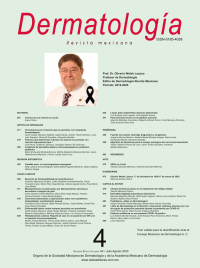Cutaneous histoplasmosis. A case report in an HIV patient and an immunocompetent patient.
Dermatol Rev Mex. 2020; 64 (4): 428-435.
Miriam Puebla-Miranda,1 Yuriria Asbel Gálvez-Juárez,2 Juan Manuel-Ruiz Matta,3 Mariana Vásquez-Ramírez,3 Julieta Carolina Corral-Chávez,6 Teresa Cristina Cuesta-Mejías,4 Zindy Jair Durán-Reyes5
1 Jefa del Servicio de Dermatología.
2 Residente de Dermatología.
3 Médico adscrito al servicio de Dermatología.
4 Médica adscrita al Servicio de Patología.
5 Residente de Anatomía Patológica.
Hospital Juárez de México, Ciudad de México.
6 Dermatóloga egresada, Hospital Dr. Manuel Gea González, Ciudad de México.
Resumen
ANTECEDENTES: La histoplasmosis es una micosis sistémica que afecta diversos órganos, entre los que se encuentra la piel y la médula ósea.
CASOS CLÍNICOS: Pacientes masculinos de 22 años de edad, el primero con SIDA e histoplasmosis diseminada que se manifestó como una dermatosis que semejaba secundarismo sifilítico; el segundo paciente era inmunocompetente con la misma enfermedad; ambos tuvieron buena evolución con el tratamiento intravenoso con anfotericina B e itraconazol.
CONCLUSIONES: Ante un paciente con VIH, conteo de CD4 menor a 65 cél/μL y lesiones dérmicas de predominio en el tronco y la cara, maculares, papulares, eritematoescamosas, debe descartarse histoplasmosis, porque en ellos la enfermedad es más severa y hasta 12.5% padece choque séptico, insuficiencia orgánica múltiple y coagulopatías.
PALABRAS CLAVE: Histoplasmosis, VIH, inmunosupresión, SIDA, Histoplasma capsulatum.
Abstract
BACKGROUND: Histoplasmosis is a systemic mycosis that affects various organs, including the skin and the bone marrow.
CLINICAL CASES: Two 22 year-old-men, the first one with AIDS and disseminated histoplasmosis mimicking secondary syphilis and the second one without any medical past history of immunosuppression with the same disease. Both had a good response of the disease with intravenous treatment with amphotericin B and itraconazole.
CONCLUSIONS: In the case of a patient with HIV, a CD4 count of lesser than 65 cells/μL and macular, papular, erythematous, squamous skin lesions predominantly on the trunk and face, histoplasmosis should be ruled out, because in them the disease is more severe and up to 12.5% have septic shock, multiple organ failure and coagulopathies.
KEYWORDS: Histoplasmosis, HIV, immunosuppression, AIDS, Histoplasma capsulatum.

